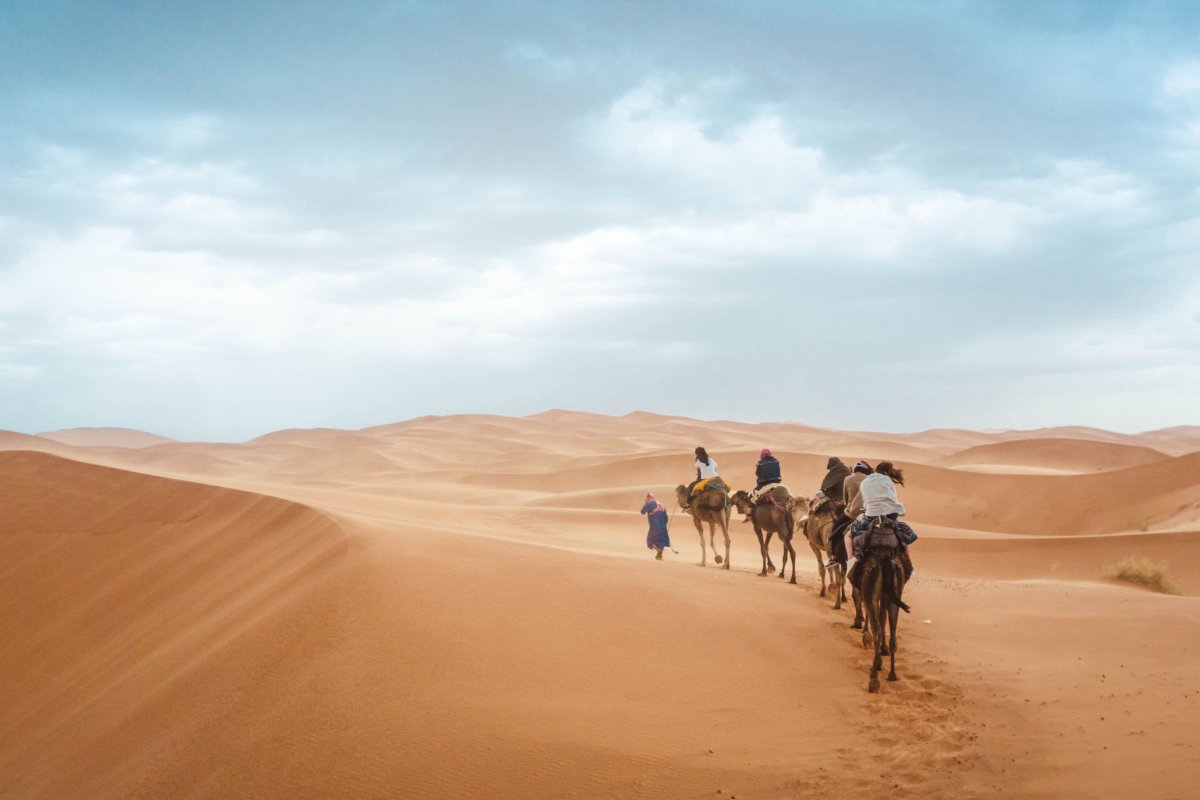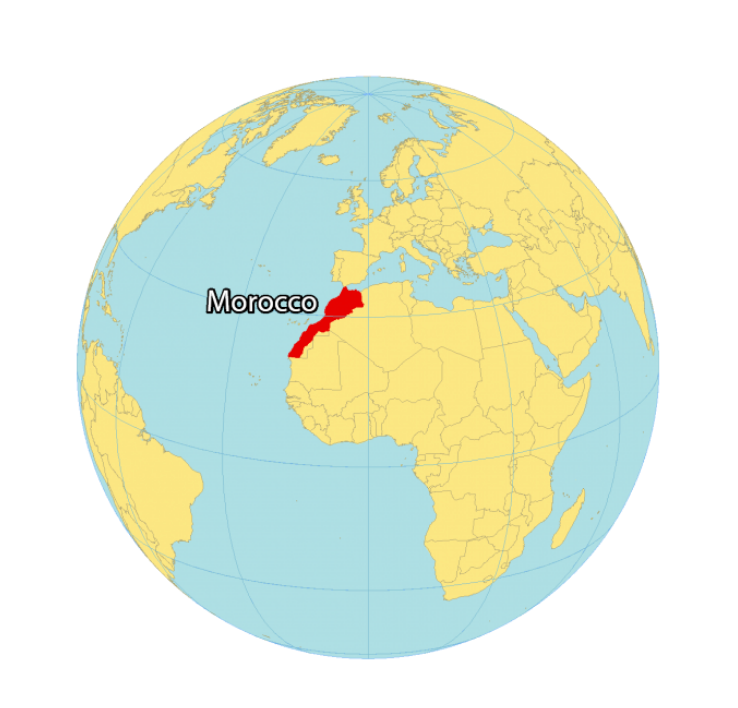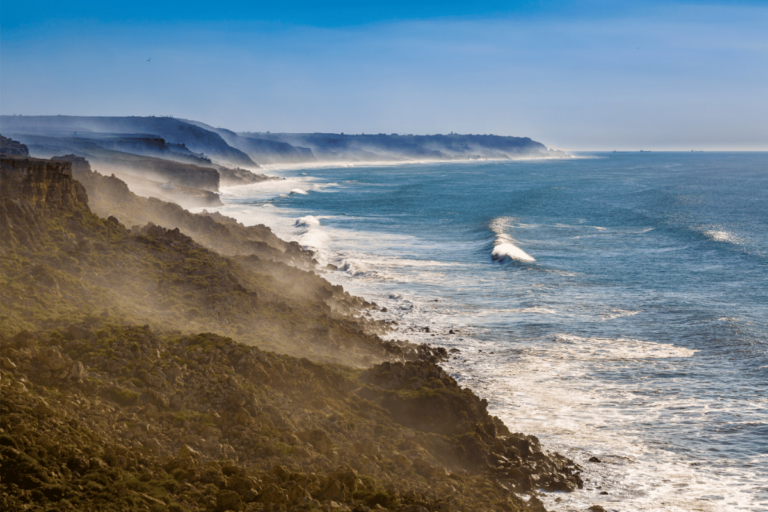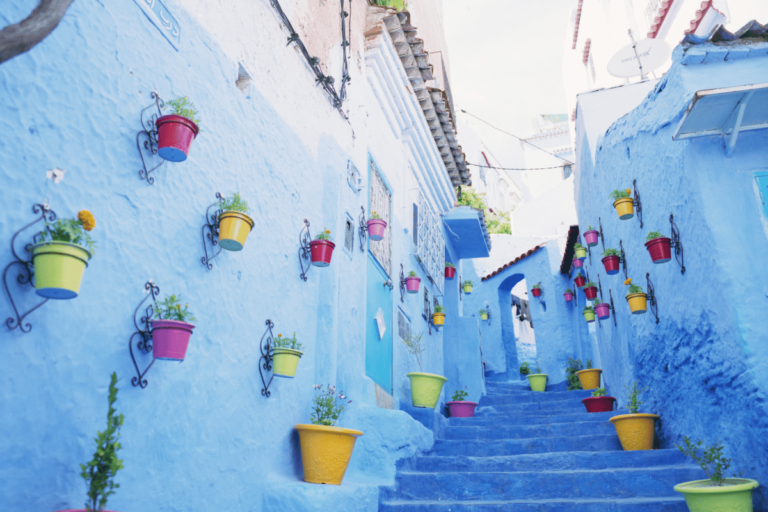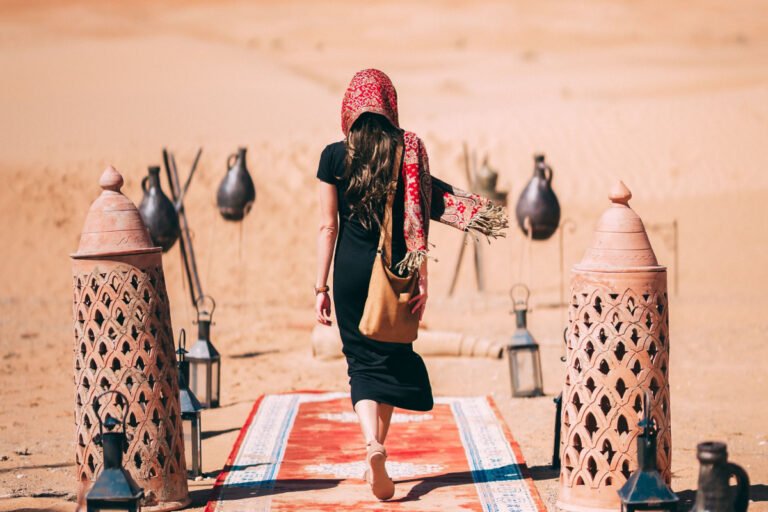Welcome to the majestic Sahara Desert, a vast expanse of golden sands that stretches as far as the eye can see.
As you embark on this incredible journey into Morocco’s desert jewel, prepare to be captivated by its awe-inspiring beauty and immerse yourself in the rich Berber culture that thrives amidst its dunes.
Step foot onto the soft, warm sand and let your senses come alive as you take in the breathtaking panorama before you.
The Sahara Desert is a place of unparalleled natural beauty, with towering dunes that shift and change with every gust of wind.
The vibrant hues of orange and gold create a mesmerizing landscape that seems straight out of a dream.
As you explore this enchanting desert, you’ll feel like an explorer discovering hidden treasures at every turn.
But it’s not just the stunning scenery that will leave you spellbound; it’s also the chance to experience the Berber culture firsthand.
These nomadic people have called the Sahara home for centuries, adapting to its harsh conditions and thriving in harmony with nature.
From their traditional clothing adorned with intricate patterns to their warm hospitality and delicious cuisine, immersing yourself in their way of life will be an unforgettable experience.
So get ready to venture deep into Morocco’s golden sands and embark on a journey like no other – one that will leave you with memories to last a lifetime.
Key Takeaways
- Ancient fortresses and kasbahs in Morocco showcase the country’s rich cultural heritage and skilled craftsmanship.
- The Sahara Desert in Morocco is home to fossil sites that reveal ancient marine life and prehistoric giants.
- When visiting the Sahara Desert, it is important to pack appropriately for the desert climate and visit during the cooler months.
- Safety precautions such as staying hydrated, wearing protective clothing, and following experienced guides are necessary when exploring the Sahara Desert.
The Beauty of the Sahara Desert
You’ll be amazed by the breathtaking beauty of the Sahara Desert, with its endless golden sands stretching as far as the eye can see.
The vastness of this desert is truly awe-inspiring, and it’s home to a diverse range of desert wildlife.
As you explore the dunes, you may catch a glimpse of camels gracefully crossing the horizon or hear the soft rustling of sand foxes darting between the dunes.
The Sahara Desert is teeming with life, from scorpions and snakes to rare species like fennec foxes and jerboas.
It’s a unique opportunity to witness nature thriving in one of the harshest environments on Earth.
One of the most captivating aspects of the Sahara Desert is its stargazing opportunities.
With little light pollution and clear skies, you’ll have an unparalleled view of the night sky.
Imagine lying back on a blanket under a canopy of twinkling stars, feeling humbled by their sheer number and brilliance.
The desert’s remote location offers an ideal setting for astronomy enthusiasts or anyone looking to experience the magic of gazing at constellations that have guided travelers for centuries.
As you immerse yourself in Berber culture, you’ll discover that it’s intricately intertwined with life in the Sahara Desert.
The Berbers are indigenous people who have adapted to this harsh environment over generations.
Their deep connection to their surroundings is evident in their traditions, cuisine, and hospitality.
You’ll have the opportunity to visit traditional Berber villages called ksars, where locals will welcome you warmly into their homes and share stories about their way of life.
The transition from exploring the beauty of nature to immersing yourself in Berber culture is seamless because both aspects are deeply connected in this region.
By understanding how these communities have thrived amidst such challenging conditions, you’ll gain a deeper appreciation for Morocco’s golden sands and all they offer beyond just their striking appearance.

Immersing in the Berber Culture
Explore the rich and vibrant Berber culture as you immerse yourself in their traditions and customs. The Berbers, also known as Amazigh people, have a deep-rooted history in the Sahara Desert. They have inhabited this region for centuries, adapting to its harsh conditions and creating a unique way of life that is both fascinating and captivating.
One way to truly experience the Berber culture is by attending desert festivals. These festivals are a celebration of their traditions, where music, dance, and storytelling take center stage. Imagine yourself sitting around a campfire under the clear night sky, surrounded by locals dressed in colorful traditional attire. The rhythmic beats of drums fill the air as dancers gracefully move to the music. It’s an enchanting experience that will leave you mesmerized by the beauty of their artistry.
To give you a glimpse into the world of Berber traditions, imagine sitting at a table filled with delicious dishes that showcase their culinary expertise. In front of you lies a tagine pot filled with tender lamb cooked with fragrant spices like cumin and coriander. On another plate, couscous is delicately arranged next to vegetables cooked to perfection. As you take your first bite, flavors explode in your mouth, leaving you craving for more. This is just a taste of what awaits when immersing yourself in the Berber culture.
As we conclude our exploration into the vibrant Berber culture, let’s transition into our next adventure: traversing the endless dunes of Morocco’s golden sands.
Traversing the Endless Dunes
Get ready to venture into the mesmerizing world of the endless dunes, where vast stretches of golden sand make up 80% of Morocco’s landscape.
As you embark on your journey through the Sahara Desert, one of the most iconic experiences awaits you: camel trekking. Riding atop these majestic creatures, you’ll traverse the undulating sand dunes, feeling every rise and fall beneath you. The rhythmic sway of the camels will transport you back in time, as this traditional mode of transportation has been used by nomadic tribes for centuries.
As you make your way deeper into the desert, a sense of isolation and tranquility envelops you. The only sounds are those created by nature itself – the gentle rustling of the wind against the sand and the soft padding footsteps of your camel.
Looking out onto the vast expanse before you, it’s hard not to be captivated by its sheer beauty. The shifting patterns in the sand create an ever-changing landscape that seems to stretch endlessly towards the horizon.
As night falls upon this magical desert realm, another breathtaking experience awaits – star gazing. With no light pollution to hinder your view, you’ll be treated to a celestial spectacle like no other. Lay back on a blanket spread across warm sands and let your eyes wander upwards as countless stars twinkle above. The immensity and clarity of the night sky will leave you awe-inspired and humbled by nature’s grandeur.
With memories etched in your mind from traversing these endless dunes and experiencing star-filled nights in this remote corner of Morocco, it’s time to move forward into uncovering hidden gems within this enchanting country without missing a beat.
Uncovering Hidden Gems
As you continue your journey through the Sahara Desert, get ready to uncover hidden gems that will leave you in awe.
Explore desert oases, where lush palm trees and crystal-clear springs provide a stark contrast to the surrounding golden sands.
Visit ancient fortresses and kasbahs, marveling at the intricate architecture and rich history they hold within their walls.
And don’t forget to venture into fossil sites, where millions of years of history are preserved in beautifully preserved fossils waiting to be discovered.
Get ready for an adventure like no other as you uncover these hidden treasures in the heart of Morocco’s golden sands.

Exploring Desert Oases
Imagine yourself walking through the vast Sahara Desert, where you stumble upon a hidden oasis, surrounded by lush palm trees and vibrant, crystal-clear pools of water.
As you approach this oasis, you can’t help but be mesmerized by its beauty and tranquility. The cool breeze rustles through the leaves of the palm trees, providing a refreshing respite from the scorching desert heat.
You notice an abundance of desert wildlife that has made this oasis their home. From colorful birds chirping in the branches above to small reptiles basking in the sun, there is a sense of harmony between nature and its surroundings.
The oasis offers a serene escape from the harsh desert environment. The palm trees provide shade and shelter for both humans and animals. The pools of water serve as a vital source of sustenance for all living creatures in this arid landscape.
As you continue your exploration of these hidden gems within the Sahara Desert, it’s fascinating to discover how these oases have sustained life for centuries. They have been vital resting points for weary travelers crossing the desert on camelback or foot. These oases also served as meeting places for local nomadic tribes who would gather here to trade goods and share stories. With their abundant water supply, they became thriving agricultural hubs where crops were cultivated using traditional methods passed down through generations.
With such intriguing history surrounding these desert oases, it’s no wonder they continue to captivate visitors from around the world.
However, there is much more to uncover beyond these pristine waterscapes. So let’s venture further into Morocco’s golden sands and delve into the captivating world of ancient fortresses and kasbahs.
Visiting Ancient Fortresses and Kasbahs
When you step foot into the world of ancient fortresses and kasbahs, a sense of wonder and history washes over you. These architectural wonders stand as testaments to the rich cultural heritage and skilled craftsmanship of Morocco. From the towering walls of Ait Benhaddou to the intricate details of Taourirt Kasbah, exploring these ancient ruins takes you on a journey back in time.
As you wander through the narrow alleyways and climb up steep staircases, it’s easy to imagine what life was like within these fortified structures. The kasbahs were once bustling with activity, serving as both homes and defense systems for local tribes and families. Each fortress tells its own unique story, with ornate carvings, decorative tilework, and hidden courtyards waiting to be discovered. It’s a mesmerizing experience to witness the blend of traditional Moroccan architecture with influences from Berber, Arab, and Spanish cultures.
Incorporating a 3 column and 3 row table in markdown format:
| Ancient Fortresses | Architectural Wonders | Historical Significance |
|---|---|---|
| Ait Benhaddou | Intricate details | Cultural Heritage |
| Taourirt Kasbah | Skilled craftsmanship | Blend of cultures |
| Hidden courtyards | Decorative tilework | Testaments to history |
With every step taken in these ancient fortresses, you can almost hear whispers from the past echoing through their walls. But now it’s time to embark on another adventure – discovering fossil sites that reveal secrets buried beneath the desert sands.
Discovering Fossil Sites
Embarking on a new adventure, you’ll be amazed by the secrets revealed in the fossil sites of Morocco. As you delve into the vastness of the Sahara Desert, you’ll come across fascinating locations where paleontological research and fossil excavation have uncovered ancient remnants that provide a window into the past.
Here are three sub-lists to guide you through this captivating journey:
- Ancient Marine Life: Imagine standing amidst towering sand dunes and stumbling upon fossils of creatures that once roamed an ancient sea that covered this arid land millions of years ago. These fossil sites offer glimpses into the diverse marine life that existed in what is now a desert.
- Prehistoric Giants: Get ready to witness the remains of colossal beasts such as dinosaurs and giant crocodiles. The Sahara Desert has yielded remarkable discoveries, including well-preserved bones and footprints of these prehistoric giants. Walking in their footsteps will make your imagination run wild.
- Cultural Significance: Beyond scientific marvels, these fossil sites hold cultural significance for the local communities. Discover how Moroccan traditions and beliefs intertwine with these ancient remnants, adding another layer of depth to your exploration.
As you uncover these hidden treasures during your visit to Morocco’s golden sands, you’ll gain a newfound appreciation for Earth’s history and its awe-inspiring diversity.
Now, let’s move on to discover some tips for creating unforgettable memories during your Sahara experience.
Tips for a Memorable Sahara Experience
Are you planning a trip to the Sahara Desert? Here are some key points to consider for a memorable experience.
First, make sure to pack appropriately for the desert climate, including lightweight and breathable clothing, sunscreen, and plenty of water.
Secondly, the best time to visit is during the cooler months of October to April when temperatures are more bearable.
Lastly, it’s important to take safety precautions such as staying hydrated, avoiding strenuous activities during peak heat hours, and following the guidance of experienced guides.
What to Pack for the Desert
Make sure you pack plenty of sunscreen and a wide-brimmed hat to protect yourself from the scorching desert sun. When you embark on your journey into the Sahara Desert, these essential items will be your best friends.
The desert heat can be intense, and without proper protection, you risk getting sunburned or even suffering from heatstroke. Along with sunscreen and a hat, it’s also advisable to bring lightweight, breathable clothing that covers your skin. Long-sleeved shirts and pants made from natural fabrics like linen or cotton are ideal for keeping cool while providing some protection against the harsh sun.
In addition to protecting yourself from the sun, there are a few other items that should make their way into your desert packing list. Don’t forget to bring a sturdy pair of walking shoes or hiking boots as you’ll be doing quite a bit of walking on uneven terrain. A good quality backpack is also essential for carrying water bottles, snacks, and any other personal belongings you may need during your adventure in the golden sands of Morocco.
Now that you’re fully equipped for your Sahara journey with sunscreen, a wide-brimmed hat, appropriate clothing, comfortable footwear, and a trusty backpack; let’s move on to the next section about the best time to visit this mesmerizing desert landscape.
Best Time to Visit
If you fancy experiencing a true desert sauna, then the best time to visit the scorching wilderness is during the blistering summer months. The Sahara Desert reaches its peak temperature during this time, with temperatures soaring well above 100 degrees Fahrenheit (38 degrees Celsius). While it may seem unbearable to some, for those seeking an authentic and challenging adventure, the sweltering heat of summer adds an extra layer of intensity to their journey.
Here are four reasons why visiting in summer can be an unforgettable experience:
- Mesmerizing landscapes: During summer, the Sahara transforms into a mesmerizing landscape of golden dunes as far as the eye can see. The intense heat creates mirages that shimmer on the horizon, adding a surreal touch to the already otherworldly beauty of the desert.
- Fewer crowds: Summer is considered off-peak season for tourism in Morocco due to the extreme temperatures. This means fewer tourists and smaller crowds at popular sites like Merzouga or Erg Chebbi. It’s an opportunity to have vast stretches of sand all to yourself and enjoy a more intimate experience with nature.
- Unique cultural experiences: In many parts of Morocco, summer marks important festivals and celebrations that provide visitors with a chance to immerse themselves in local traditions and customs. From music festivals under starlit skies to vibrant markets bustling with activity, there are plenty of opportunities for cultural encounters during your trip.
- Thrilling activities: For adrenaline junkies, summer offers thrilling activities like sandboarding down massive dunes or going on exhilarating camel treks across endless stretches of sand. These adventures become even more exhilarating under the scorching sun.
As you plan your trip into Morocco’s golden sands, it’s important to keep safety precautions in mind without compromising on excitement and exploration. Here are some essential safety precautions to consider while embarking on exhilarating camel treks across Morocco’s endless stretches of sand under the scorching sun:
Safety Precautions
Now that you have a good idea of the best time to visit the Sahara Desert, let’s talk about some safety precautions you should keep in mind before embarking on your journey into Morocco’s golden sands. The vastness and harsh environment of the desert require careful planning and preparation to ensure a safe and enjoyable experience.
One of the most important safety measures is to stay hydrated at all times. The extreme heat can quickly deplete your body’s water supply, so it is crucial to drink plenty of fluids throughout the day. It is also advisable to wear loose-fitting, lightweight clothing that provides protection from the sun while allowing air circulation. Additionally, make sure to apply sunscreen regularly to avoid sunburns.
Emergency preparedness should be a top priority when venturing into such an isolated and unforgiving environment. Before setting off, inform someone trustworthy about your itinerary and expected return date. Carry a well-equipped first aid kit with essential supplies like bandages, antiseptic ointment, and any necessary medication. Familiarize yourself with common desert hazards such as scorpions or venomous snakes and know how to respond in case of an encounter.
To help you visualize these safety precautions better, here’s a handy table summarizing some key tips:
| Safety Precautions | Description |
|---|---|
| Stay Hydrated | Drink plenty of fluids throughout your journey to prevent dehydration in the desert heat. |
| Dress Appropriately | Wear loose-fitting, breathable clothing that protects you from the sun but allows for air circulation. |
| Apply Sunscreen | Regularly apply sunscreen with a high SPF rating to protect your skin from harmful UV rays. |
| Inform Someone | Share your travel plans with a reliable person who can raise an alarm if you fail to return on time. |
| Carry First Aid Kit | Pack a well-stocked first aid kit containing essentials like bandages, antiseptic ointment, and necessary medication. |
| Be Aware of Hazards | Educate yourself about potential desert hazards like scorpions or snakes and know how to handle encounters. |
By following these safety measures and being well-prepared for emergencies, you can ensure a memorable and safe adventure in the mesmerizing golden sands of the Sahara Desert.
Frequently Asked Questions
What is the best time of year to visit the Sahara Desert in Morocco?
The best time to visit the Sahara Desert in Morocco is during the cooler months from October to April. You can enjoy activities like camel trekking, sandboarding, and stargazing, while also immersing yourself in the rich cultural experiences of the desert.
Are there any specific safety precautions to keep in mind while exploring the Sahara Desert?
When exploring the Sahara Desert, it’s important to take safety measures and have essential equipment. Be prepared with sun protection, plenty of water, a compass, and a guide who knows the area well.
How long does it typically take to traverse the Sahara Desert on a camel trek?
Embark on a captivating camel trek through the Sahara Desert! Experience the breathtaking beauty and immerse yourself in the rich culture as you traverse this vast expanse. The duration of a camel trek varies, typically lasting several days. Enjoy unforgettable experiences along your journey.
Are there any restrictions or guidelines for interacting with the local Berber communities?
When interacting with local Berber communities in the Sahara Desert, cultural immersion is key. Be prepared for language barriers, but don’t let that deter you from connecting and learning from these fascinating people.
What are some recommended clothing and gear items to pack for a trip to the Sahara Desert?
Ready to embark on your Sahara Desert adventure? Don’t forget these must-haves: lightweight, breathable clothing for the scorching heat; a wide-brimmed hat to shield from the sun; sturdy boots for sandy terrain; and of course, plenty of water!
Conclusion
In conclusion, your journey into Morocco’s golden sands of the Sahara Desert is sure to be an unforgettable adventure. As you immerse yourself in the Berber culture, you’ll gain a deep appreciation for their traditions and way of life.
Traversing the endless dunes, you’ll witness the mesmerizing beauty of nature at its finest. But it doesn’t stop there. The Sahara Desert holds hidden gems waiting to be uncovered. From ancient ruins to breathtaking oases, each discovery will leave you in awe of this vast and mysterious land.
As you embark on this remarkable journey, remember to come prepared with sunscreen, plenty of water, and a sense of wonderment. With every step you take across the soft sand beneath your feet, let yourself be enveloped by the magic that surrounds you.
So go ahead and embrace this once-in-a-lifetime experience as Morocco’s golden sands beckon you with open arms. Let the idiom ‘the world is your oyster’ guide your exploration as you discover all that the Sahara has to offer. Don’t miss out on this captivating adventure that promises memories to last a lifetime.

The Editorial Team is a passionate group of Morocco enthusiasts dedicated to sharing the beauty, culture, and wonders of this captivating country. With diverse backgrounds and a deep love for travel, we strive to bring you engaging and informative content that inspires your Moroccan adventures. From uncovering hidden gems and sharing local insights to exploring mouthwatering cuisine and showcasing the vibrant lifestyle, our team is committed to providing you with valuable resources and exciting stories that enhance your exploration of Morocco. Join us on this journey as we celebrate the rich heritage and unforgettable experiences that make Morocco truly special.

